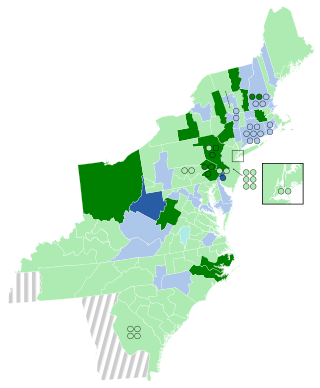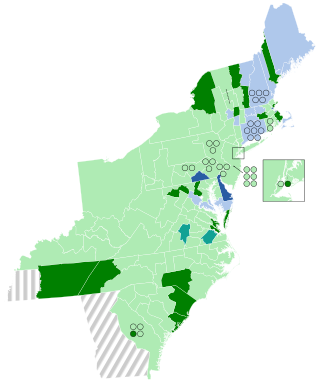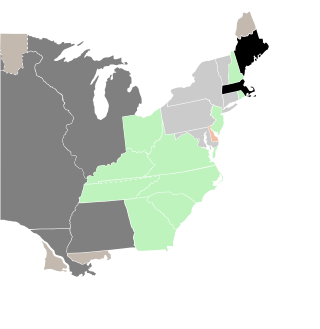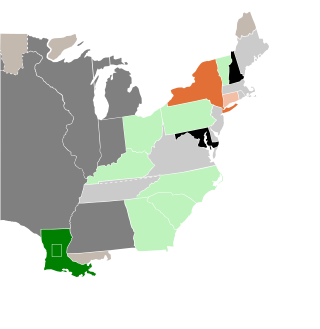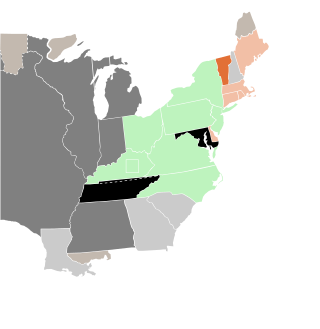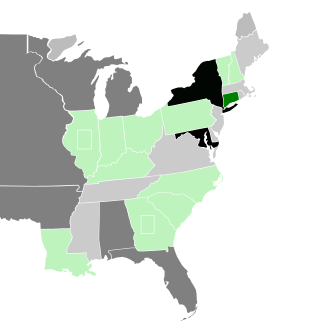| Elections in Massachusetts |
|---|
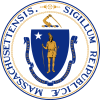 |
Massachusetts elected its members November 2, 1818. Massachusetts's electoral law required a majority for election, necessitating additional elections in five districts on April 5, 1819, and July 26, 1819.
Contents
This was the last election in which the District of Maine was part of Massachusetts. The District became the State of Maine during the 16th Congress.
| District [lower-alpha 1] | Incumbent | This race | |||
|---|---|---|---|---|---|
| Member | Party | First elected | Results | Candidates [lower-alpha 2] | |
| Massachusetts 1 "Suffolk district" | Jonathan Mason | Federalist | 1817 (Special) | Incumbent re-elected. | √ Jonathan Mason (Federalist) 64.5% Andrew Ritchie (Democratic-Republican) 35.5% |
| Massachusetts 2 "Essex South district" | Nathaniel Silsbee | Democratic-Republican | 1816 | Incumbent re-elected. | √ Nathaniel Silsbee (Democratic-Republican) 64.2% Timothy Pickering (Federalist) 34.5% Thomas Stevens (Federalist) 1.3% |
| Massachusetts 3 "Essex North district" | Jeremiah Nelson | Federalist | 1804 1806 (Retired) 1814 | Incumbent re-elected. | √ Jeremiah Nelson (Federalist) 87.0% Joseph Bradley Varnum (Democratic-Republican) 7.9% Others 5.1% |
| Massachusetts 4 "Middlesex district" | Timothy Fuller | Democratic-Republican | 1816 | Incumbent re-elected. | √ Timothy Fuller (Democratic-Republican) 63.9% Samuel P. Fay (Federalist) 36.1% |
| Massachusetts 5 "Hampshire South district" | Elijah H. Mills | Federalist | 1814 | Incumbent retired. New member elected. Federalist hold. | First ballot (November 2, 1818): Samuel Lathrop (Federalist) 48.1% Isaac C. Bates (Federalist) 22.7% Thomas Shepherd (Democratic-Republican) 19.6% Joseph Lyman (Federalist) 9.5% Second ballot (April 5, 1819): √ Samuel Lathrop (Federalist) 55.5% Thomas Shepherd (Democratic-Republican) 27.7% Joseph Lyman (Federalist) 16.8% |
| Massachusetts 6 "Hampshire North district" | Samuel C. Allen | Federalist | 1816 | Incumbent re-elected. | √ Samuel C. Allen (Federalist) 86.2% Elihu Lyman (Democratic-Republican) 8.0% Others 5.8% |
| Massachusetts 7 "Berkshire district" | Henry Shaw | Democratic-Republican | 1816 | Incumbent re-elected. | First ballot (November 2, 1818): Henry Shaw (Democratic-Republican) 48.8% Henry W. Dwight (Federalist) 47.0% Ambrose Hall 2.7% Others 1.5% Second ballot (April 5, 1819): √ Henry Shaw (Democratic-Republican) 50.8% Henry W. Dwight (Federalist) 45.8% Others 3.4% [1] |
| Massachusetts 8 "Plymouth district" | Zabdiel Sampson | Democratic-Republican | 1816 | Incumbent re-elected. | √ Zabdiel Sampson (Democratic-Republican) 59.6% William Bourne (Federalist) 40.4% |
| Massachusetts 9 "Barnstable district" | Walter Folger Jr. | Democratic-Republican | 1816 | Incumbent re-elected. | √ Walter Folger Jr. (Democratic-Republican) 51.3% John Reed Jr. (Federalist) 48.7% |
| Massachusetts 10 "Bristol district" | Marcus Morton | Democratic-Republican | 1816 | Re-elected | √ Marcus Morton (Democratic-Republican) 55.0% Francis Baylies (Federalist) 43.8% Hodijah Baylies 1.2% |
| Massachusetts 11 "Worcester South district" | Benjamin Adams | Federalist | 1816 | Incumbent re-elected. | √ Benjamin Adams (Federalist) 59.8% Sumner Barstow (Democratic-Republican) 40.2% |
| Massachusetts 12 "Worcester North district" | Solomon Strong | Federalist | 1814 | Incumbent retired. New member elected. Federalist hold. | √ Jonas Kendall 63.5% Edmund Cushing (Democratic-Republican) 31.7% Others 4.8% |
| Massachusetts 13 "Norfolk district" | Nathaniel Ruggles | Federalist | 1812 | Incumbent lost re-election. New member elected. Democratic-Republican gain. | √ Edward Dowse (Democratic-Republican) 54.9% Nathaniel Ruggles (Federalist) 45.1% |
| Massachusetts 14 "1st Eastern district" District of Maine | John Holmes | Democratic-Republican | 1816 | Incumbent re-elected. | √ John Holmes (Democratic-Republican) 93.6% Others 6.4% |
| Massachusetts 15 "2nd Eastern district" District of Maine | Ezekiel Whitman | Federalist | 1808 1810 (Lost) 1816 | Incumbent re-elected. | √ Ezekiel Whitman (Federalist) 54.0% Arthur Ware (Democratic-Republican) 46.0% |
| Massachusetts 16 "3rd Eastern district" District of Maine | Benjamin Orr | Federalist | 1816 | Incumbent lost re-election. New member elected. Democratic-Republican gain. | First ballot (November 2, 1818): Mark L. Hill (Democratic-Republican) 48.6% Benjamin Orr (Federalist) 38.0% Others 13.4% Second ballot (April 5, 1819): Mark L. Hill (Democratic-Republican) 52.1% [lower-alpha 3] Benjamin Orr (Federalist) 41.3% Joshua Head (Federalist) 7.3% [2] Third ballot (July 26, 1819): √ Mark L. Hill (Democratic-Republican) 52.1% Benjamin Orr (Federalist) 47.9% [3] |
| Massachusetts 17 "4th Eastern district" District of Maine | John Wilson | Federalist | 1816 | Incumbent lost re-election. New member elected. Democratic-Republican gain. | First ballot (November 2, 1818): Martin Kinsley (Democratic-Republican) 41.3% John Wilson (Federalist) 29.9% Leonard Jarvis (Democratic-Republican) 24.7% Others 4.1% Second ballot (April 5, 1819): Martin Kinsley (Democratic-Republican) 48.3% John Wilson (Federalist) 29.9% Leonard Jarvis (Democratic-Republican) 15.7% Others 6.1% Third ballot (July 26, 1819): √ Martin Kinsley (Democratic-Republican) 61.7% John Wilson (Federalist) 29.3% Leonard Jarvis (Democratic-Republican) 2.4% Others 6.7% |
| Massachusetts 18 "5th Eastern district" District of Maine | Thomas Rice | Federalist | 1814 | Incumbent lost re-election. New member elected. Democratic-Republican gain. | First ballot (November 2, 1818): James Parker (Democratic-Republican) 49.7% Peter Grant (Federalist) 41.8% Joshua Gage (Democratic-Republican) 5.3% Others 3.2% Second ballot (April 5, 1819): √ James Parker (Democratic-Republican) 57.3% Thomas Rice (Federalist) 34.8% Joshua Gage (Democratic-Republican) 7.2% |
| Massachusetts 19 "6th Eastern district" District of Maine | Joshua Gage | Democratic-Republican | 1816 | Ran in the 18th district and lost re-election. New member elected. Democratic-Republican hold. | √ Joshua Cushman (Democratic-Republican) 56.1% Thomas Rice (Federalist) 43.9% |
| Massachusetts 20 "7th Eastern district" District of Maine | Enoch Lincoln | Democratic-Republican | 1818 (Special) | Incumbent re-elected. | √ Enoch Lincoln (Democratic-Republican) 66.6% Samuel A. Bradley (Federalist) 33.4% |

